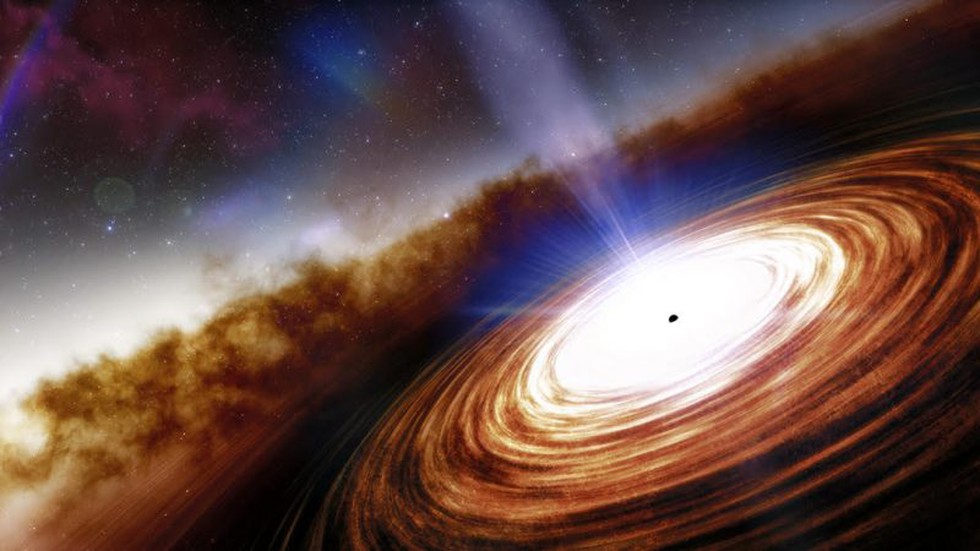
About Quasar:
- A quasar is an extremely active and luminous type of active galactic nucleus (AGN).
- An AGN is nothing more than a supermassive black hole that is active and feeding at the centre of a galaxy.
- All quasars are AGNs, but not all AGNs are quasars.
- Quasars are thought to form in regions of the universe where the large-scale density of matter is much higher than average.
- They are among the most luminous, powerful, and vibrant objects known in the universe.
- How are they formed?
- An active galaxy is one in which the central supermassive black hole is consuming large amounts of matter.
- The infall of matter into the black hole is so great that all the material can't enter the black hole at the same time, so it forms a queue as a spiralling accretion disk.
- The matter—in the form of huge clouds—falls into the disk, with the inner parts of the cloud closer to the black hole orbiting faster than the outer parts (just like planets closer to the sun orbit faster than those farther away).
- This creates a shear force that twists the clouds, causing them to bump into their neighbours as they move around the black hole at velocities ranging from 10% of the speed of light up to over 80%.
- This friction from fast-moving gas clouds generates heat, and the disk becomes so hot—millions of degrees—that it shines brightly.
- Some of the material in the disk is also funnelled away from the black hole in a highly luminous, magnetically collimated jet.
- The hot accretion disk and the jet combine to make the nucleus of the active galaxy shine so brightly that it can be seen far across the universe.
- The brightest quasars can outshine all of the stars in the galaxies in which they reside, which makes them visible even at distances of billions of light-years.
- Most quasars have been found billions of light-years away.
2. What are Anoxic Marine Basins?

About Anoxic Marine Basins:
- An anoxic basin is a body of water without oxygen.
- Permanent anoxic basins form when there is a strong layering of the water column created in a cup-like formation on the ocean floor.
- The layering is caused by density differences due to salt concentration or temperature.
- Once stratification occurs, circulation with the rest of the ocean is minimised, and microorganisms consume the oxygen in the water.
- In most anoxic basins, the water is extremely stagnant and can have mixing times of many thousand years.
- They range from a few hundred metres to several kilometres across and from 10 metres to 500 metres deeper than the surrounding seafloor.
- They can’t support animal life and are populated primarily by microbes and some very specialised fungi with different metabolisms than creatures in oxygen-rich environments.
- Some of them rely on molecules such as nitrate for respiration, and some get their carbon from gases like carbon dioxide (CO2) and methane (CH4) instead of eating other organisms or particles of organic matter.
- Many anoxic basins also contain toxic chemicals, which are produced by geothermal activity or by microbes living in the basins.
- Some also contain salt domes, big mounds of hardened salt.
- In some anoxic basins, methane and other gases collect in reservoirs beneath the seafloor.
- The gases can percolate upward, pushing up domes of sediment on the seafloor that are called mud volcanoes.
- The gases can burst through the soft sediments, creating "mini-eruptions" of wispy columns of sediment-filled water.
3. Morodharo
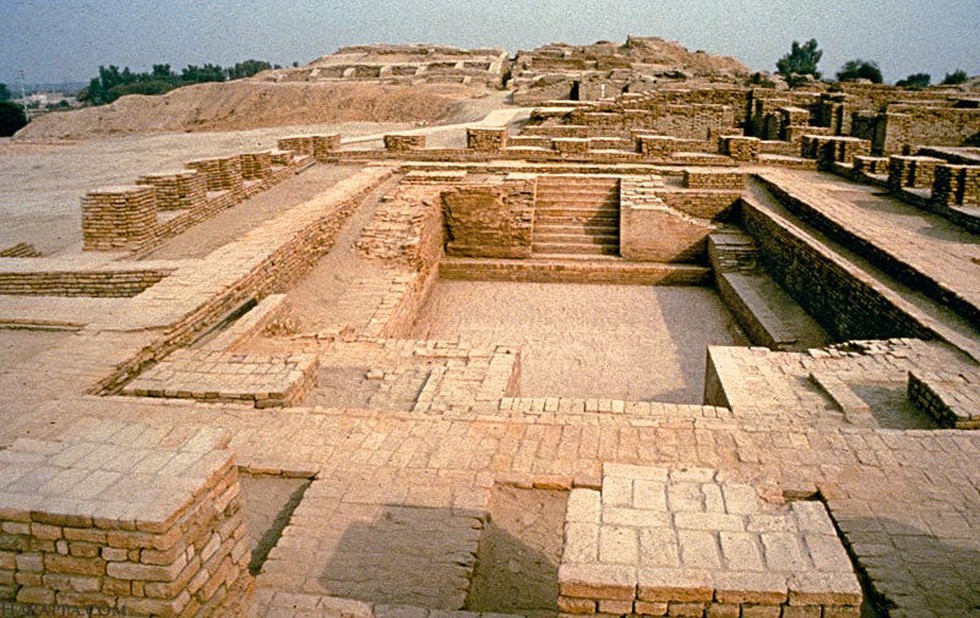
About Morodharo:
- It is a fortified settlement dating back to the Harappan era.
- Location: Kutch District, Gujarat
- Features:
- The settlement looks mature (2,600-1,900 BCE) to late (1,900-1,300 BCE) Harappan.
- The fortification measures 102 m east to the west and 58 m north to the south.
- The thickness of the wall is an average of 3.3 m.
- It has a 10x10 m platform on the south-west side and a well on the north-east.
- Burial cairns, which are mounds of stones to demarcate a boundary, are also found here.
- Harappan pottery with perforated jar sherds, reserved slipware, and terracotta cakes were unearthed. All these items have a striking resemblance to those found in Dholavira.
Key Facts about Harappan Civilization:
- The Indus Valley/Harappan civilisation was the first urban civilisation in South Asia, coexisting with Mesopotamia and Egypt.
- The Harappan civilisation occupied the largest area (approximately 8,00,000 sq. km) among the three civilisations.
- Harappa (Punjab, Pakistan), Mohenjo-Daro (Sindh, Pakistan), Dholavira, Lothal, and Surkotada (Gujarat, India), Kalibangan in Rajasthan, and Banawali and Rakhigarhi (Haryana, India) are the major cities in the Harappan period.
- The features of town planning of the Harappan civilisation included:
- Rectangular grid pattern: The Harappan cities were designed on a grid pattern, with streets running in a north-south and east-west direction, forming a well-organised Streets and lanes were cutting across one another almost at right angles, thus dividing the city into several rectangular blocks.
- Planned streets and alleyways: The streets and alleyways of Harappan cities were planned and constructed with precision. They were wide enough to allow the movement of carts and pedestrians, and some streets had covered drains running alongside them.
- Fortification: The cities were surrounded by fortified walls made of mud bricks, providing protection against robbers, cattle raiders, and floods.
- Division of cities: The city was divided into two parts: an upraised citadel and the lower part of the city.
- Upper part: An upraised citadel in the western part was used for constructing buildings of large dimensions, such as granaries, administrative buildings, pillared halls, and courtyards.
- Lower part: Below the citadel in each city lay a lower town containing brick houses, which were inhabited by the common people.
- Material used: They used burnt bricks on a large scale in almost all kinds of constructions, and there was the absence of stone buildings during Harappan culture.
- Residential areas: The cities were divided into distinct residential areas. Houses were made of baked bricks, often with multiple stories, indicating a well-developed urban society. The houses were generally built around courtyards, and some had private wells and properly ventilated bathrooms. No window faced the streets, and the houses had tiled bathrooms.
- Sophisticated drainage systems: The drainage system of the Harappans was elaborate and well laid out. Every house had drains, which opened into the street drains. Drains were made of mortar, lime, and gypsum.
- Granaries and storage facilities: The cities had well-planned granaries and storage facilities to store surplus agricultural produce.
4. What is U.S.-India Defense Accelerator Ecosystem (INDUS-X)?

About the U.S.-India Defense Accelerator Ecosystem (INDUS-X):
- It was launched in June 2023 during the state visit of the Prime Minister of India to the US.
- Objective: To expand strategic technology partnerships and defence industrial cooperation between governments, businesses, and academic institutions in India and the US.
- INDUS X will be a defence innovation bridge, which will inter-alia, include Joint Challenges, Joint Innovation Fund, Academia engagement, Industry-startup connect, investment by private entities in defence projects, mentoring by experts and niche technology projects etc.
- It will focus on advancing high-tech cooperation and fostering joint research, development, and production opportunities in the defence sector.
- The initiative aims to explore possibilities for co-producing jet engines, long-range artillery, and infantry vehicles.
- India’s Innovations for Defense Excellence (iDEX) and the Office of the Secretary of Defense (OSD), US, are leading INDUS-X activities.
What is Innovations for Defense Excellence (iDEX)?
- It is the flagship scheme of the Ministry of Defence, Govt of India, launched in 2018.
- The objective of the scheme is to cultivate an innovation ecosystem in the Defence and Aerospace sector by collaborating with startups, innovators, MSMEs, incubators, and academia.
- iDEX offers grants and support for R&D with significant potential for future adoption in Indian defence and aerospace.
- It is currently engaged with around 400+ Startups and MSMEs.
- It is recognized as a game-changer in the defence ecosystem, iDEX has received the PM Award for Innovation in the defence sector.
- Funding: It will be funded and managed by a ‘Defence Innovation Organization (DIO)’ which has been formed as a ‘not for profit’ company as per the Companies Act 2013 for this purpose, by the two founder members i.e., Defence Public Sector Undertakings (DPSUs): HAL and BEL.
- iDEX will function as the executive arm of DIO, carrying out all the required activities, while DIO will provide high level policy guidance to iDEX.
5. What is Mission Aspides?
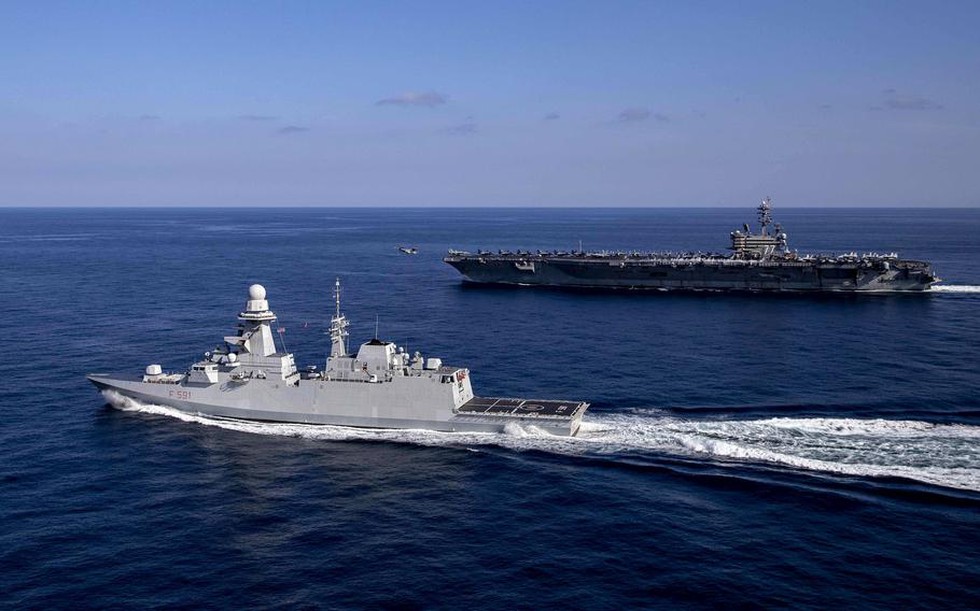
About Mission Aspides:
- It is a European Union (EU) naval mission to protect cargo ships in the Red Sea from attacks from Yemen’s Houthi rebels.
- It will send European warships and airborne early warning systems to the Red Sea, Gulf of Aden and surrounding waters.
- So far, France, Germany, Italy and Belgium have said they plan to contribute ships.
- Aspides vessels, whose operational command centre will be in the Greek city of Larissa, will have orders to fire on the Houthis only if they attack first and will not be authorised to shoot pre-emptively.
- The mission is planned for one year but may be renewed.
Key Facts about the Red Sea:
- It is a semi-enclosed inlet(or extension) of the Indian Ocean between the continents of Africa and Asia. It is one of the world’s warmest seas.
- It is connected to the Arabian Sea and the Indian Ocean to the south through the Gulf of Adenand the narrow strait of Bab El-Mandeb.
- The northern portion of the Red Sea is bifurcated by the Sinai Peninsula into the Gulf of Aqaba and the Gulf of Suez, where it is connected to the Mediterranean Sea via the famous Suez Canal.
- Bordering Countries:
- Yemen and Saudi Arabia border the Red Sea to the east.
- It is bordered by Egypt to the north and west and by Sudan, Eritrea, and Djibouti to the west.
- This sea has a surface area of roughly 438,000 km2 and is about 2,250 km in length.
- The maximum width of the sea is 355 km, and the sea’s deepest point is 3,040 m at the central Suakin Trough, with the sea’s estimated average depth being 490 m.
- Islands: Some well-known islands include Tiran Island, which is located near the mouth of the Gulf of Aqaba, and Shadwan Island, which is located at the entrance of the Gulf of Suez.
6. BharatNet Project

About BharatNet Project:
- It is one of the biggest rural telecom projects in the world.
- It is implemented in a phased manner to all Gram Panchayats in the country to provide non-discriminatory access to broadband connectivity to all the telecom service providers.
- Objective: To enable access providers like mobile operators, Internet Service Providers (ISPs), Cable TV operators, and content providers to launch various services such as applications like e-health, e-education and e-governance in rural and remote India.
- The project was approved in 2011.
- It is being executed by a Special Purpose Vehicle namely Bharat Broadband Network Limited (BBNL), which was incorporated in 2012 under the Indian Companies Act 1956.
- The Telecom Commission approved the implementation of the project in three phases.
- BharatNet Phase-I:
- It was approved in 2011 the project for the creation of the National Optical Fibre Network (now BharatNet) to provide broadband connectivity at the Gram Panchayat (GP) level by connecting block headquarters to GPs by using existing fibre of Central Public Sector Undertakings such as Bharat Sanchar Nigam Limited and RailTel Corporation of India Limited and laying incremental fibre to bridge the connectivity gap up to the GPs.
- BharatNet Phase-II
- It was approved in 2017, which integrates the implementation experience of Phase-I of the project and aligns it with the vision of Digital India.
- The modified strategy provides an optimal mix of media (OFC, Radio and satellite) to connect Gram Panchayats (GPs).
- Under Phase II, GPs are to be connected through multiple implementing models like the State-led Model, Private Sector Model and CPSU Model, along with last-mile connectivity in GPs through Wi-Fi or any other suitable broadband technology.
- In the third phase from 2019 to 2023, a state-of-the-art, future-proof network, including fibre between districts and blocks, with ring topology to provide redundancy would be created.
7. National Council for Transgender Persons

About the National Council for Transgender Persons:
- It is a statutory body constituted under the Transgender Persons (Protection of Rights) Act 2019 to safeguard the rights of transgender persons in India.
- It is responsible for monitoring and evaluating the implementation of the provisions of the Transgender Persons (Protection of Rights) Act, 2019 and making recommendations to the government on measures to promote and protect the rights of transgender persons.
- Aims:
- To focus on livelihood issues as well as to raise awareness about the trans community for achieving the goal of social justice so that transpersons are accepted within families and in the larger society.
- To ensure to set up of transgender welfare boards in all states and also ensure that essential needs of the transgender community, like housing, food, healthcare, and education are met.
- Composition
- The Union Minister of Social Justice & Empowerment is the Chairperson (ex-officio).
- The Union Minister of State for Social Justice & Empowerment is the Vice-Chairperson (ex-officio) of the council.
- The other members of the Council include representatives of various Ministries/Departments
- Five representatives of the transgender community.
- Representatives of the National Human Rights Commission (NHRC) and the National Commission for Women (NCW), representatives of State Governments and UTs, and experts representing NGOs.
- Functions:
- It advises the Central Government on the formulation of policies, programmes, legislation and projects with respect to transgender persons.
- It Monitors and evaluates the impact of policies and programmes designed for achieving equality and full participation of transgender persons.
- It reviews and coordinates the activities of all the departments of Government and other Governmental and non-Governmental Organisations which are dealing with matters relating to transgender persons.
- It redresses the grievances of transgender persons.
- Performs such other functions as may be prescribed by the Central Government.
8. Rubber Board

About Rubber Board:
- It is a statutory organisation constituted under the Rubber Act, 1947.
- It functions under the administrative control of the Ministry of Commerce and Industry.
- Functions:
- It is responsible for the development of the rubber industry in the country by assisting and encouraging research, development, extension and training activities related to rubber.
- It also maintains statistical data of rubber, takes steps to promote marketing of rubber and undertake labour welfare activities.
- A crucial function of the Rubber Board is issuing licences to rubber producers, manufacturers, and exporters/traders. This licence, known as the "Rubber Board licence/registration," is mandatory for anyone involved in rubber manufacturing and export
- Structure:
- It is headed by a Chairman appointed by the Central Government.
- It has 28 members representing various interests of the natural rubber industry.
- The activities of the Board are exercised through Five Departments viz. General Services, Extension & Advisory Services, Research Services (rubber Research Institute of India), Training (Rubber Training Institute) & Finance.
- Headquarters: Kottayam, Kerala.
9. ASEAN-India Trade in Goods Agreement
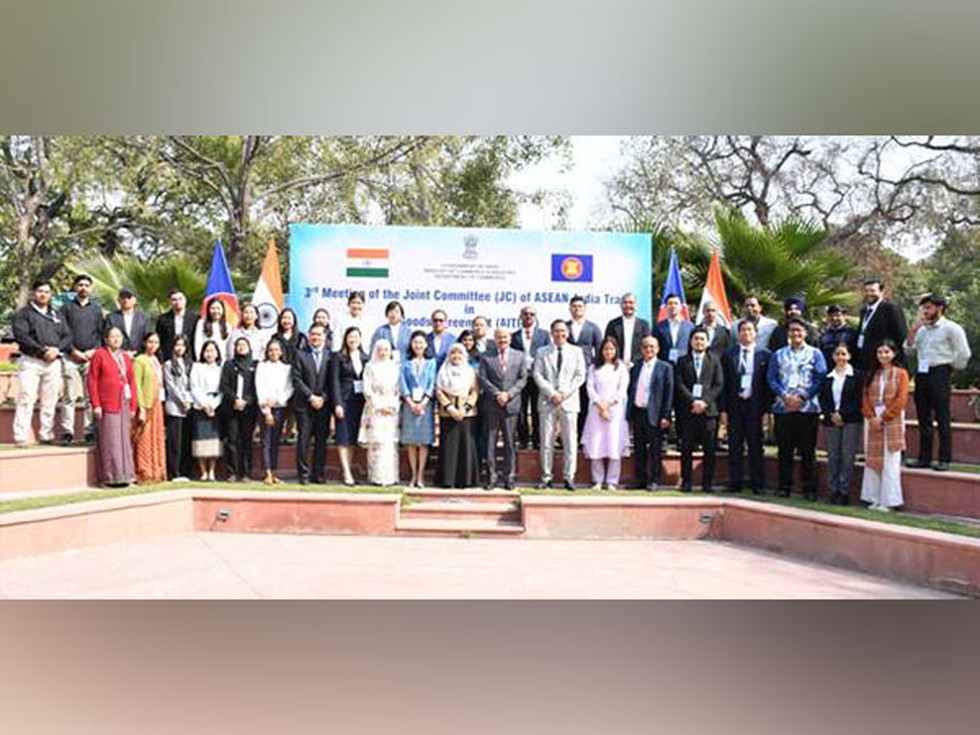
About ASEAN-India Trade in Goods Agreement:
- It is a trade deal between the ten member states of ASEAN and India.
- This agreement was signed at the 7th ASEAN Economic Ministers-India Consultations in Bangkok, Thailand in 2009.
- The agreement, which came into effect in 2010, is sometimes referred to as the ASEAN-India Free Trade Agreement.
- The Agreement covers trade in physical goods and products; it does not apply to trade in services.
- ASEAN and India signed a separate ASEAN-India Trade in Services Agreement in 2014.
What is ASEAN?
- It is a group of the Association of Southeast Asian Nations, which was established in 1967 with the signing of the Bangkok declaration.
- Founding members: Indonesia, Malaysia, Philippines, Singapore and Thailand.
- Presently ASEAN comprises 10 member states namely Indonesia, Malaysia, Philippines, Singapore, Thailand, Brunei, Laos, Myanmar, Cambodia and Vietnam.
- It promotes intergovernmental cooperation and facilitates economic, political, security, military, educational, and socio-cultural integration between its members and other countries in Asia.
10. Vaitarna River
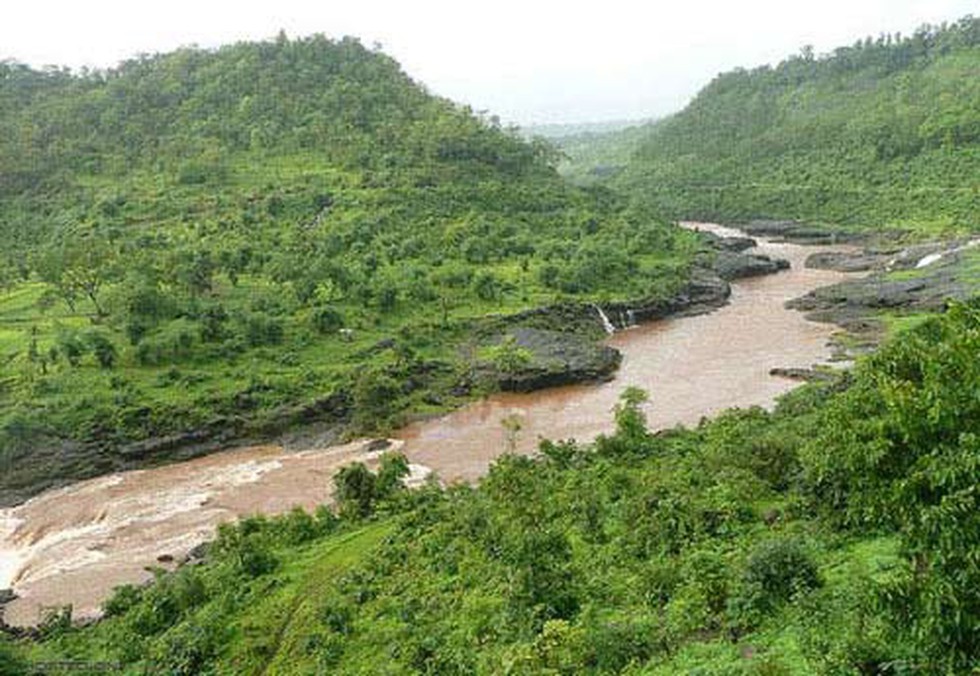
About Vaitarna River:
- It is one of the west flowing rivers in the region North of Mumbai and South of the Tapi River.
- It originates in the Trimbakeshwar Hills of Nasik district of Maharashtra.
- It receives most of the rainfall from the South West monsoon during June to October. Almost 98% of the annual rainfall of the basin is received during this period.
- Tributaries: The main tributaries are Pinjal, Ganjai, Surya, Daharji and Tansa.
- The catchment area of Vaitarna basin completely lies in Thane and Nasik districts of Maharashtra.
- It drains an area of 2019 sq. km before it falls into the Gulf of Khambhat.
Key facts about Bull Shark
- They’re known to be aggressive towards humans and are thought to be one of the most dangerous shark species in the world.
- Habitat: These are frequently spotted in tropical coastal areas worldwide, including shallower waters along coastlines.
- Bull sharks have a unique ability to tolerate freshwater and saltwater habitats, meaning they can sometimes be found venturing into rivers and travelling great distances upstream.
- It reproduces through viviparity, the process in which the embryo develops within the mother’s body, leading to live birth.
- Conservation status
- IUCN: Vulnerable


























































































































































.png)
.png)
.png)
.png)
.png)


.png)
.png)
.png)





.png)
.png)






.png)
.png)
.png)
.png)
.png)
.png)
.png)
.png)
.png)

.png)







.png)
.png)


.png)
.png)
.png)


.png)

.png)
.png)





.jpg)

.png)
.png)


.png)

.png)
.png)
.png)

.jpg)

.jpg)


.png)

.png)
.png)
.png)
.png)
.png)
.png)
.png)
.png)
.png)
.png)




.png)

.png)





.png)
.png)
.png)
.png)
.png)
.png)
.png)
.png)
.png)
.png)
.jpg)
.jpg)

.png)
.png)
.png)
.png)
.png)
.png)
.png)
.png)
.png)
.png)
.png)
.png)
.png)
.png)
.png)
.png)
.png)
.png)
.png)
.png)
.png)
.png)



.png)
.png)

.jpg)
.jpg)


.jpg)
.jpg)
.jpg)
.jpg)
.jpg)

.jpg)








.jpg)
.jpg)
.jpg)
.jpg)
.jpg)

















.jpg)
.jpg)







.jpg)


















.jpg)
.jpg)






























































































.jpg)
.jpg)


























.jpg)

.jpg)










.jpg)








.jpg)




.jpg)










.jpg)


















.jpg)












































.jpg)














.jpg)
.jpg)
.jpg)





.jpg)

.jpg)
.jpg)





































































.jpg)


































.jpg)
.jpg)
















































.jpg)












.jpg)


.jpg)




.jpg)
.jpg)
.jpg)

.jpg)
.jpg)
.jpg)
.jpg)

.jpg)
.jpg)
.jpg)

.jpg)
.jpg)
.jpg)
.jpg)
.jpg)
.jpg)
.jpg)
.jpg)

.jpg)


.jpg)
.jpg)
.jpg)
.jpg)
.jpg)
.jpg)
.jpg)
.jpg)
.jpg)
.jpg)











.jpg)
.jpg)





.jpg)
.jpg)
.jpg)
























.jpg)
























.jpg)









.jpg)
.jpg)







.jpg)
.jpg)









































.jpg)
.jpg)
.jpg)
.jpg)
.jpg)

.jpg)
.jpg)
.jpg)
.jpg)
.jpg)


.jpg)
.jpg)
.jpg)
.jpg)
.jpg)

.jpg)
.jpg)
.jpg)
.jpg)
.jpg)
.jpg)
.jpg)
.jpg)
.jpg)
.jpg)
.png)

.png)
.png)

.png)
.png)
.png)
.png)


.jpg)
.jpg)

.jpg)
.jpg)
.jpg)

.png)
.png)
.png)
.png)
.png)
.png)
.png)

.png)
.png)
.png)
.png)
.png)
.png)
.png)
.png)
.png)
.png)





































































-min.png)



.png)




.png)








































